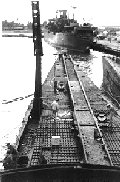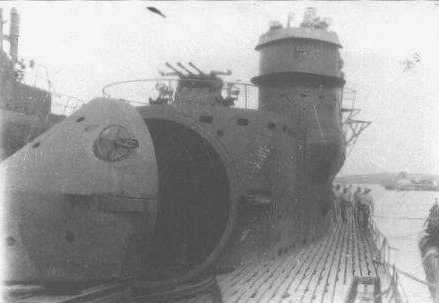Jap Submarines
In Sept '45 three Jap subs (I-14, I-400, I-401) with American
crews passed through Guam on their way to Pearl Harbor. They were later
scuttled according to information from several sources.
The 14 carried two (2) seaplanes: the 400 & 401 carried three (3) planes. These planes
were meant to extend a submarine's reconnaissance range, but some could
carry two 170-pound bombs. In fact, it was just such a submarine (I-25)
that made the long journey from Japan to the Oregon coast. They sighted
Cape Blanco light in southern Oregon, and
on 9 September 1942 a seaplane flew over the the forest inland and dropped
its two bombs which exploded and set the forest afire. However, Oregon had
been saturated by heavy rains and the fires quickly burned themselves out.Note the launch tracks running from the hanger door to the bow. On the port side a large folding derrick could be raised to load the planes aboard after landing. The two larger subs had a 6" gun on the after deck
 Periscope Shot |
 Conning Tower |
 Seaplane Hanger Door |
 Seaplane Launch |

The following pictures of the Jap sub I-14 are courtesy of Vic Webb who served as a member of the prize crew which brought the I-14 from Japan to Pearl Harbor. Vic served aboard the USS PerchII during the war and after his cruise on the I-14 he served aboard the USS Sea Cat.

Because of the conning tower being off center to make room for the hanger they were very lopsided and bounced like a cork in rough seas. We started out in a terrific storm and didn't serve meals for three days because almost everyone was seasick. We had sandwiches and believe me, I never missed a meal.

This is a view taken inside the hangar while the Jap crew were busy working in there. Before we left Japan this hangar was filled with Japanese rifles that were taken back for souvenirs, I guess. Each member of our crew received one rifle and one bayonet as a souvenir.
We were in Sasebo standing armed watches on a nest of Jap fleet type subs that still had their full crews aboard. It was cold weather and the Japs would go ashore for us and bring back firewood to the subs and we had a big GI can on the fantail of one of the subs. We used to have a nice fire in there and would huddle pretty close to it to keep warm. There was one hatch further back aft that we would use to go down and make a tour through the boats every hour. The fire bucket was in the middle of the fan tail so we could always walk around it to get to the hatch. We were four sailors to a watch team and three of us carried a .45 each and the fourth man had a Very pistol that we were to fire in an emergency and the Eurayle (AS-22) would send help over to us. This worked fine because the war was over and the Japs wanted to be friendly, but one night someone (probably the watch before ours) moved the GI can over to one side of the fantail. Expecting it to be in the center, one of our guys went to walk around it to get to the after hatch, and stepped into open air and started to fall overboard. The first reaction is to grab hold of anything to stop you from falling. Well, the closest thing was another of our sailors so he grabbed and instead of one going overboard we now had two guys in the water. Fortunately, I was one of the two still left on deck. It wasn't a bad problem and we got the guys back on the boat, but they were soaking wet and freezing cold. Since we needed help we fired the Very pistol to get help from the tender, less than a mile away. No response. After about 15 minutes we fired again, and again and again and never got any response. It was a good thing that the Jap crew had not revolted because we would have been in real trouble. This all happened about two or three days after they signed the surrender in Tokyo. Finally at the end of our watch our relief arrived and were very surprised to hear that anything had happened. Nothing serious, just another example of our great efficiency.